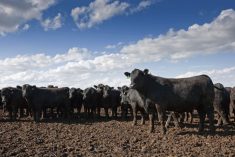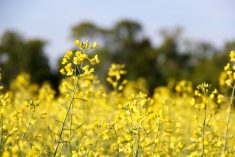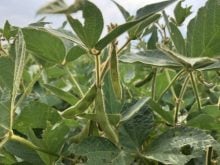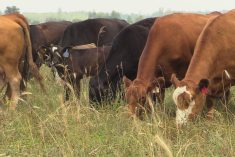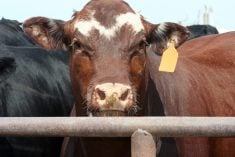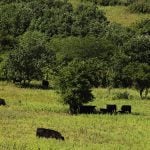Compared to last week, western Canadian yearling prices were $3 to as much as $6 higher, but calf prices were relatively unchanged.
Major feedlot operators were very aggressive on heavier calves and yearlings weighing 700-850 lbs. Yearlings over 850 lbs. were also well bid but not as strong as their lighter-weight counterparts.
Feed barley prices for new crop are slightly softer and deferred live cattle futures continue to trend higher. The calf market was unchanged but there were bursts of energy in the major feedlot regions. Feedlot operators focused on local cattle in the Lethbridge area.
Read Also

U.S. grains: Soybeans rise on China demand hopes; corn and wheat rebound
Chicago Board of Trade soybean, corn and wheat futures rose on Monday on signs of progress towards the end of a record-long U.S. government shutdown, along with expectations of a revival of U.S. soybean exports to China, analysts said.
In other areas of Western Canada, dryer conditions have tempered demand for grassers. Backgrounding operators were more aggressive last week because the price insurance program allowed them to lock in favourable margins right from the start of feeding. We haven’t seen an opportunity like this for years. The volume of calves under 600 lbs. is drying up at this time of year so the market appears to be firming on tight supplies. August feeder cattle futures reached up to $163; this would be the highest price since November 2017. There is a very bullish feel on the feeder market, there is no doubt about it.
South of Edmonton, a larger group of mixed steers on full health program and ready to move onto full grain ration weighing 920 lbs. were quoted at $177; similar-quality heifers weighing 900 lbs. were quoted at $166. In southern Alberta, a larger group of 810-lb. black steers with medium to lower flesh were valued at $202 and similar quality 790-lb. steers dropped the gavel at $203. In Manitoba, Charolais-based steers with medium to lower flesh levels averaging 890 lbs. were reported at $178 and similar-quality 790-lb. steers were valued at $196. In central Saskatchewan, a smaller group of larger-frame medium-flesh Simmental-based steers weighing 835 lbs. were valued at $190 and similar-quality heifers weighing just over 800 lbs. were quoted at $173.
In the Lethbridge area, a small group of black steers weighing 715 lbs. reached up to $211. Early in the week, a smaller group of Angus-based heifers weighing 710 lbs. were valued at $185 landed in the feedlot in the same region. In Manitoba, red steers weighing 550 lbs. were reported at $233 and black heifers weighing 522 lbs. were quoted at $207. In central Saskatchewan, a small group of black steers weighing just over 600 lbs. were quoted at $218 and Charolais heifers weighing 610 lbs. reportedly sold for $192.
Beef demand is expected to surge over the next four to six months. While Canada is struggling with vaccine rollout, the U.S. is accelerating progress. U.S. restaurant traffic is only marginally lower than 2019. Wholesale beef values have jumped sharply over the past couple of weeks. April 2022 live cattle futures reached up to $133 last week. Strength in deferred futures is pulling up nearby cash feeder values.
— Jerry Klassen manages the Canadian office of Swiss-based grain trader GAP SA Grains and Produits Ltd. and is president and founder of Resilient Capital, specializing in proprietary commodity futures trading and market analysis. Jerry consults with feedlots on risk management and writes a weekly cattle market commentary. He can be reached at 204-504-8339 or via his website at ResilCapital.com.






